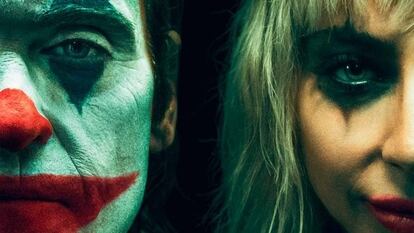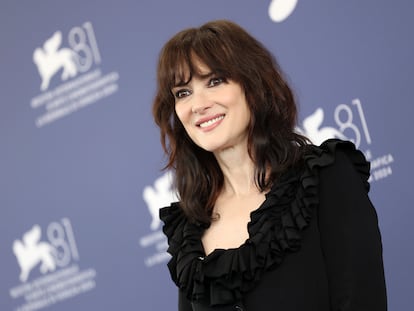Batman triumphs without Batman: Movies and TV shows turn to the Joker, Penguin and even the butler Alfred
Warner has transformed the superhero universe into its most treasured asset. Not only is the sequel about the Gotham clown now out in cinemas, a series about the iconic mobster is also enjoying success

The fascination with the Batman universe in film and television seems endless, even when the Dark Knight himself isn’t on screen. This Friday, Joker: Folie à Deux hits theaters, offering a fresh take on Batman’s most notorious foe and his girlfriend, Harley Quinn — a character who has made her mark in films, comics, and television. Meanwhile, the Max platform is enjoying the success of The Penguin, a series centered on another of Gotham’s iconic mobsters, who previously appeared as a supporting character in the Gotham series, which explored the origins of the infamous city’s commissioner.
Although a 2004 film featuring Catwoman flopped at the box office, numerous other adaptations have thrived. Titans, a series about Batman’s teenage sidekicks, ran for four seasons, while Batwoman, about Bruce Wayne’s cousin, lasted three seasons. Even the unconventional Pennyworth, which delves into the youth of Alfred, Batman’s butler, and Bruce Wayne’s parents, secured three seasons. To top it all off, an animated series, Batwheels, brings joy to children with its adventures featuring Batman’s iconic vehicle. As if that weren’t enough, the masked hero recently became the first superhero to receive a star on the Hollywood Walk of Fame.
Comic book readers have sought refuge in the shadows of Gotham City for decades, and in today’s Hollywood, dominated by sequels and franchises, Warner Bros. has discovered the ideal audiovisual formula within this iconic city of superheroes.
“The mythology of Batman and Gotham is 85 years old. Not only is it intricately crafted, but it also allows for seemingly contradictory approaches while maintaining its essence. Moreover, it boasts a roster of villains that may be even more compelling than the hero,” explains writer and illustrator David Rubín, who has just released the Spanish edition of Joker: The World, set in Madrid.
He continues: “The narrative is so adaptable that it invites many perspectives — from the whimsical, offbeat Harley Quinn animated series to the sequel of Joker, which diverges from the comics and doesn’t require Batman. The Penguin resembles The Sopranos more than a typical superhero series. Gotham City itself acts as a vital character in this folklore, providing a backdrop for every story.” In this landscape, Batman stands as Warner’s paramount icon, akin to a new Bugs Bunny in an era when the beloved rabbit struggles to find relevance in pop culture.
The Batman universe also provides creators with a recognizable brand that supports projects across various genres in an industry that often penalizes originality. Despite the impending release of the new Joker — a musical sequel packed with references to Bugs Bunny — Matt Reeves’ darker The Batman saga is already introducing its own version of the clown, which will star Barry Keoghan.
The audience is not confused by Lady Gaga’s portrayal of Harley Quinn, even though Margot Robbie’s role as the character is still fresh in their minds thanks to the movies Suicide Squad and Birds of Prey. There’s little concern about the presence of two Jokers in the movie listings. “Back in 2000, the general public might have been confused, but today we’re so accustomed to the multiverse that it no longer creates conflict. It’s about experiencing the same character in different ways,” Rubín explains. In this landscape, the contradictions between stories and tones don’t matter.

Is Batman, then, the worst of Batman? “Spider-Man and Batman have the best gallery of villains, but while you empathize with the former because he’s a loser who can’t make ends meet, I find it hard to empathize with a multimillionaire who likes to dress up in Velcro at night to beat up criminals,” says Rubín. He argues that Batman’s most compelling stories often revolve around his villains, with Joker and Two-Face among his favorites — characters not as frequently used but featured in Joker: Folie à Deux.
“They are villains, but they also have familial ties — Batgirls, the various Robins… In fact, they just announced another film, Dynamic Duo. We want to learn more about these characters and their backstories, perhaps even too much,” explains screenwriter and comic book agent David Macho. He underscores the importance of Gotham’s underworld: “The city itself is a character. It’s dark and morbid, which is intriguing — what monster lurks in the shadows? This allure is far greater than the purity of Metropolis. The night allows us to explore the interplay of light and shadow.”
He continues: “The 1950s comics inspired Adam West’s camp vision of Batman. About 20 years later, Tim Burton’s films and Bruce Timm’s animated series [where Harley Quinn was introduced] brought a fresh twist to the franchise. While Batman can deliver one type of story, it’s his supporting characters that add depth and variety. Batman is like a jug filled with liquor, but it’s the cocktail that really shines.”
Macho identifies a pivotal moment in the phenomenon: “Batmania took off in 1989; before that, it had little success. Today, the brand guarantees a baseline audience, and this stability allows for bolder, more unconventional projects.”

Villains have prominently featured. Just a decade ago, Gotham premiered, a series that followed police officer James Gordon (Ben McKenzie) as he navigated the corruption of a city populated by young versions of iconic characters like the Riddler, Catwoman, and Poison Ivy. Similar to Joker, a teenage Bruce Wayne was introduced, beginning to don the Batsuit during the show’s final year, which spanned five seasons and 100 episodes. The series also offered one of the most eccentric and acclaimed interpretations of the Joker, portrayed by Cameron Monaghan.
The series came out at the same time as the show Titans, where Robin evolves into Nightwing and forms his own superhero team, eventually including two additional Robins. In the show, Batman was portrayed by veteran Iain Glen, who had already hung up his cape.
The Batman franchise includes Bruce Waynes of all ages, even unborn. A notable example is Pennyworth, a series that reimagined Alfred the butler as a young agent of the British Empire in the 1960s, where he encounters Bruce and Martha Wayne for the first time in London. During the series, Batman’s parents had a daughter, the missing older sister.
Another unconventional project is Kite Man, an animated series on Max, a spin-off of Harley Quinn aimed at an adult audience — complete with plenty of sex and profanity — set in a bar for Gotham’s secondary villains, reminiscent of Cheers.
Meanwhile, there’s Batwheels, a children’s series featuring superhero vehicles that has also inspired comic adaptations and is designed for merchandising.

Batman ranks as the second most successful superhero at the box office. According to The Numbers, Batman films have grossed approximately $6 billion globally, trailing only behind Spider-Man, which has earned around $9 billion. The highest-grossing Batman film remains The Dark Knight Rises, the conclusion of Christopher Nolan’s trilogy, with a staggering $1.082 billion in earnings. Todd Phillips’ first Joker film closely followed, despite being aimed solely at adult audiences. On the other end of the spectrum, Halle Berry’s Catwoman stands out as the biggest box office failure. “It’s still a brand that generates significant profits. And while the Joker may be anti-establishment, he ultimately belongs to a machine that doesn’t care about those ideals,” explains Rubín.
Comics are seizing the economic opportunities presented by Hollywood. In conjunction with the release of the Joker sequel, the ECC publishing house is capitalizing on the moment by stocking shelves with titles featuring the villain throughout September and October. In addition to Rubín’s Spanish edition, they are releasing Joker: Catch a Clown, a collectible compilation of the 10 most famous stories about the Joker. Other notable titles include Joker/Harley Quinn: The Devil’s Advocate, Batman: The Joker’s War, and Joker: Year One. The lineup also features reprints of miniseries such as Penguin: Pain and Prejudice and Batman/Catwoman, along with ongoing series like Birds of Prey — which includes characters such as Batwoman and Harley Quinn — Nightwing, and Teen Titans Go! There’s even a chronological collectible dedicated to Batman.
A new Gotham comic is always on the shelf, with various authors continually reinterpreting the characters that inhabit the city. Rubín concludes: “These icons are highly malleable, and each era and author brings forth different perspectives. The canon is so fluid that no single version can be considered definitive. And that’s what makes them immortal.”
Sign up for our weekly newsletter to get more English-language news coverage from EL PAÍS USA Edition
Tu suscripción se está usando en otro dispositivo
¿Quieres añadir otro usuario a tu suscripción?
Si continúas leyendo en este dispositivo, no se podrá leer en el otro.
FlechaTu suscripción se está usando en otro dispositivo y solo puedes acceder a EL PAÍS desde un dispositivo a la vez.
Si quieres compartir tu cuenta, cambia tu suscripción a la modalidad Premium, así podrás añadir otro usuario. Cada uno accederá con su propia cuenta de email, lo que os permitirá personalizar vuestra experiencia en EL PAÍS.
¿Tienes una suscripción de empresa? Accede aquí para contratar más cuentas.
En el caso de no saber quién está usando tu cuenta, te recomendamos cambiar tu contraseña aquí.
Si decides continuar compartiendo tu cuenta, este mensaje se mostrará en tu dispositivo y en el de la otra persona que está usando tu cuenta de forma indefinida, afectando a tu experiencia de lectura. Puedes consultar aquí los términos y condiciones de la suscripción digital.
More information
Archived In
Últimas noticias
Welcome to the post-religion era: The idea of Christianity as the absolute truth has become obsolete
‘I thought you would like it’: The risky sexual practice popularized by TV shows and TikTok
The digitalization of tourism: ‘They promise experiences and gave us the worst possible one’
Mexican peso defies uncertainty with forecasts of a new period of stability in 2026
Most viewed
- Sinaloa Cartel war is taking its toll on Los Chapitos
- Reinhard Genzel, Nobel laureate in physics: ‘One-minute videos will never give you the truth’
- Oona Chaplin: ‘I told James Cameron that I was living in a treehouse and starting a permaculture project with a friend’
- Why the price of coffee has skyrocketed: from Brazilian plantations to specialty coffee houses
- Silver prices are going crazy: This is what’s fueling the rally











































